What You Can Do to Help Relieve Your Baby’s Torticollis

It’s alarming to see your baby’s head tilt to one side. Torticollis — Latin for “twisted neck” — can develop in boys or girls from birth through 3 months of age. “Torticollis can be frightening for parents. But most kids do very well, especially when torticollis is identified early and treated quickly,” says pediatrician David Burke, DO.
The condition, also called wry neck, can follow crowding in the uterus (as seen with twins and breech births). If a fetus doesn’t have much room to move around, the head may get stuck in one position for days or weeks.
This tightens and shortens one of the “strap muscles” that turn the head. These sternocleidomastoid muscles (SCMs) run from the collarbone to behind the ear.
The tighter SCM pulls the fetus’s head to one side, tilting it — typically to the left, reflecting the position babies find most comfy in the uterus.
Birth trauma can also cause torticollis.
What are the signs of torticollis?
The most common sign is a constant head tilt to one side, with the chin pointing to the opposite shoulder — and a reluctance to turn the other way.
Another sign can be a flat or misshapen head, called plagiocephaly. This can accompany torticollis because the skull bones haven’t yet fused. The tight neck muscle promotes lying on one side of the head, changing its shape.
Preemies are at greater risk of plagiocephaly because their skull bones are even less developed, and they are often tied in one position to a ventilator.
“Many kids have more flattened head shapes today because we want them sleeping on their backs to reduce the risk of sudden infant death syndrome (SIDS),” says Dr. Burke. “Although the head shape may be more flattened, it’s much safer than allowing kids to sleep on their bellies.”
How is torticollis treated?
Torticollis will often self-correct when treated early — ideally, within the first month or two, says Dr. Burke. If parents wait until babies are 3 months of age or older, treatment can take longer.
“Your pediatrician will explain how to reposition the baby and do infant massage and stretches. Or, they may refer you to physical therapy. Parents can begin home exercises immediately,” he says.
What kind of stretches can help your baby?
Parents massage the baby’s neck and back muscles, then do gentle stretching exercises several times a day.
“Osteopathic physicians can also do manipulative therapy, using a gentle hands-on techniques to guide tissues into a more relaxed position,” says Dr. Burke. “This allows the neck to straighten by restoring alignment and releasing tissue tightness.”
When the head tilt is significant or the muscle is really tight, more aggressive physical therapy is quite helpful in the first three months.
What does repositioning involve?
Repositioning essentially helps babies do their own physical therapy. “You turn the babies so they’re facing the opposite direction from which they want to turn,” explains Dr. Burke.
“For example, if you place babies so they’re facing the wall in their crib, they’ll have to stretch their neck muscles to see you at the bedside.”
Siblings help when they play with the baby on the floor, encouraging the baby to follow them with his head in the restricted direction.
Appropriate tummy time is also important. Several times a day, when babies are awake, put them on their bellies for 20 minutes, Dr. Burke advises. This encourages them to turn their heads from side to side, push up on their arms and increase their muscle tone.
“We recommend doing this for all babies, but tummy time can correct mild cases of plagiocephaly and make babies’ heads nice and round,” he says.
What if treatment doesn’t work?
A frequency-specific microcurrent device can deliver low-level electric current to kids who are at least 3 to 4 months of age to further relax the tight neck muscle.
For older kids with more severe torticollis, botulinum toxin (Botox®) can be injected to keep the tight neck from contracting too much, says Dr. Burke.
If kids still don’t respond to treatment, pediatricians refer them to the eye doctor for a visual exam. Some babies may tilt their heads to see better because their eyes are crossed, a condition called strabismus.
Further intervention will be needed for plagiocephaly if a baby’s ears are uneven, if one eye opens more than the other or if it causes vision problems.
Does torticollis also affect older kids?
Torticollis can occur in older children when a neck lymph node gets infected after a fever. “A big, painful, swollen lymph node may call for a round of antibiotics,” says Dr. Burke. Older kids can also develop torticollis after a neck injury or from sleeping “wrong.”
But when it comes to your newborn, his message is clear: “If you have concerns, talk to your pediatrician sooner rather than later.”
This will give your baby plenty of time for treatment and timely referrals, if needed.
link





